Let’s learn how to build piano scales.
We shall look at various kinds of scales in this section. We will first of all learn how to build major scales and minor scales. Minor scales include natural or pure minor scales, harmonic minor scales and melodic minor scales. Then we learn how to form chromatic, pentatonic and blues scales and more.
First of all, we need to understand what are half steps and whole steps.
What is a half step? It is the distance from one pitch to the next nearest pitch either up or down. This interval is often called a semitone. For example the distance between C and C sharp on your piano keyboard is a semitone. So is the distance between D and D sharp, E and F, and B and C.
What is a whole step? It is two adjacent half steps. This interval is often called a whole tone. Examples of whole steps are the distance between C and D, D and E, E and F sharp, and B flat and C.
My new book, Piano Scales Made Simple, will help you with your scales. Go here to get it at a discounted price.
Video (Watch this Lesson):
A diatonic scale is a series of eight successive notes that are arranged in a systematic relationship of whole steps and half steps. The eighth note is a duplicate of the first. There are two types of diatonic scales – major and minor scales.
How to Form a Major Scale
Let’s learn how to build a major scale.
A major scale consists of eight notes. It is arranged in a pattern of whole steps and half steps. How do you construct a major scale? Simply start with the name of the scale (also known as the root), followed by a whole step, whole step, half step, whole step, whole step, whole step, half step. Let’s say you’re in the key of C, the notes of the C major scale are C D E F G A B C. C to D is a whole step. D to E is a whole step. E to F is a half step. F to G is a whole step. G to A is a whole step. A to B is a whole step. B to C is a half step.
The formula for forming major scales no matter the key is whole step – whole step – 1/2 step – whole step – whole step – whole step – half step. W-W-H-W-W-W-H
What if we were in the key of G? The notes of the G major scale are G A B C D E F Sharp. Notice how we use F sharp instead of F. In any major scale, there must be a whole step between the 6th and 7th tones of the scale so E had to be followed by a whole step, bringing us to F sharp.
To learn more about scales, check out my course, Learn Scales & Music Theory & Give Yourself An Upper Hand.
Notes of the C Major Scale: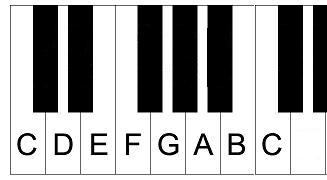
How to Form Minor Piano Scales
Each major key has its relative minor key. The relative minor scale is built upon the sixth tone of the major scale. For instance, the sixth tone in the C major scale is A, therefore the relative minor of C is A minor. C and A minor have the same key signature. In this case, the minor and major scales have the same number of tones. The difference between the major and minor scales is the pattern of the whole steps and half steps.
There are three types of minor scale. They are the pure or natural minor scale, harmonic minor scale and the melodic minor scale. Let’s learn how to build these piano scales.
How to Form a Natural or Pure Minor Scale
This scale starts on the sixth degree of its relative major scale. It ascends or descends for one octave using the signature of the major scale. The formula for building a natural minor scale is whole step – half step – whole step – whole step – half step – whole step – whole step. W-H-W-W-H-W-W
As an example, let’s take a look at the A natural minor scale. The notes are A B C D E F G A. In a natural (pure) minor scale the half steps occur between 2-3 and 5-6. It can be clearly seen that this scale makes use of the same notes of the relative major scale except for the arrangement of the whole steps and half steps.
Notes of the A minor natural scale: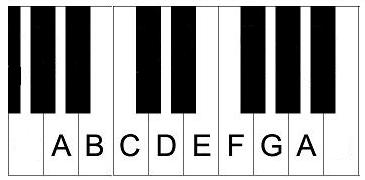
Learn how to build/play scales with Piano For All lessons.
How to Build a Harmonic Minor Scale
Like the natural (pure) minor scale, the harmonic minor scale starts on the sixth degree of its relative major scale. It ascends or descends for one octave using the major scale’s key signature, except for the 7th tone which is raised 1/2 a step. For instance, in an A harmonic minor scale, instead of playing G, G sharp is played.
The formula for forming a harmonic minor scale is whole step – half step – whole step – whole step – half step – whole step and a 1/2 step – half step. W-H-W-W-H-W 1/2-H (W 1/2 = whole-step and a half). The half steps occur between 2-3, 5-6 and 7-8, while there’s a distance of a step and a half between 6-7.
Example: In an A harmonic minor scale the notes are A B C D E F G# A.
Notes of the A minor harmonic scale: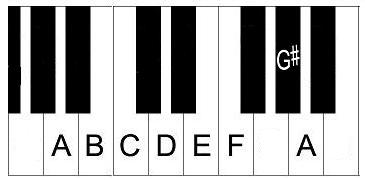
How to Build a Melodic Minor Scale
Next in our lesson on piano scales we take a look at the melodic minor scale. This minor scale also begins on the 6th degree of the relative major scale. It ascends or descends for one octave using the major scale’s key signature. However when ascending the 6th and 7th tones are raised half a step. When descending, you simply use the tones of the natural or pure minor scale.
The formula for a melodic minor scale is whole step – half step – whole step – whole step – whole step – whole step – half step. W-H-W-W-W-W-H The descending formula is the natural minor scale formula backwards. In the melodic minor scale ascending, the half steps occur between 2-3 and 7-8.
Example: In an A melodic minor scale the notes are A B C D E F# G# A (ascending), and A G F E D C B A (descending).
Notes of the A minor melodic scale: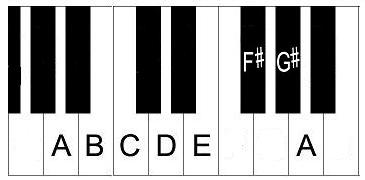
Remember to use the natural minor scale when descending.
Minor Scales: Natural, Harmonic and Melodic
- C Minor Scale
- C Sharp Minor Scale
- D Minor Scale
- E Flat Minor Scale
- E Minor Scale
- F Minor Scale
- F Sharp Minor Scale
- G Minor Scale
- A Flat Minor Scale
- A Minor Scale
- B Flat Minor Scale
- B Minor Scale
How to Build Chromatic Scales
Let’s learn how to form chromatic piano scales. This scale is pretty straightforward. You move in half steps. It makes use of accidentals (sharps and flats) depending on whether you are ascending or descending, in connection with the key signature. For the ascending scale you use sharp signs and natural signs, and for the descending scale you use flat signs and natural signs. Chromatic scales have a number of enharmonic tones. Enharmonic tones are tones which are “spelled” differently but sound the same, example C sharp and D flat.
Example: In the key of C, the chromatic scale is C C# D D# E F F# G G# A A# B C (ascending), and C B Bb A Ab G Gb F E Eb D Db C (descending).
Notes of the C chromatic scale: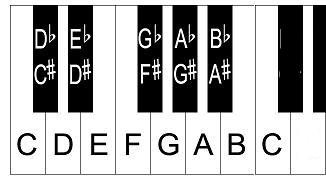
We now know how to form major, natural minor, melodic minor, harmonic minor and chromatic piano scales. Now it’s time to practice these scales in different keys. But above all, have fun!
Major Scales
- C Major Scale
- C Sharp Major Scale
- D Major Scale
- E Flat Major Scale
- E Major Scale
- F Major Scale
- F Sharp Major Scale
- G Major Scale
- A Flat Major Scale
- A Major Scale
- B Flat Major Scale
- B Major Scale
More Scales
- Piano Scales in the Key of A and D Minor
- Music Scales in the Key of E Minor and D Major
- Major and Minor Piano Music Scales in All Keys
- Piano Blues Scales
- Pentatonic Scales
- Whole Tone Scale
Whole Tones and Semitones (Half Steps and Whole Steps)
Be sure to check out the Piano For All piano lessons. It’s my favorite online course for learning how to play piano.
Return from Piano Scales to Piano Keyboard Home Page.